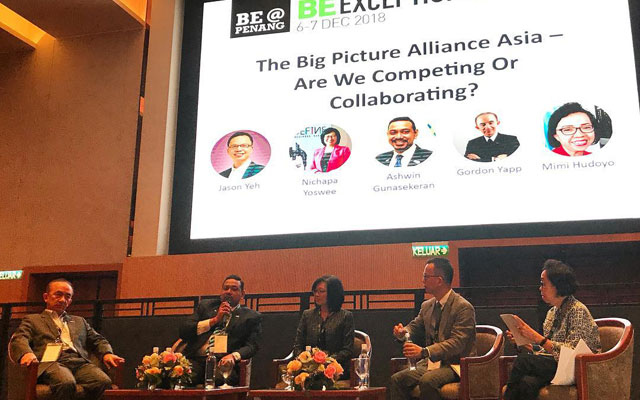As competition for business events heats up among Asian CVBs, bureau chiefs say the traditional approach of CVB collaboration needs to make way for other forms.
Speaking on the panel, The Big Picture: Alliance Asia – Are We Competing or Collaborating at BE@Penang 2018 on December 6, CVB heads agreed that bureaus have their own directions and objectives to prioritise.

Gordon Yapp, CEO of Sabah Convention Bureau, explained that as Asian destinations are not as “matured” as European competitors, each Asian state or city CVB will have very different KPIs. Sabah Convention Bureau, for instance, is still finding its way to bring both the private and government sectors onto the same page.
Ashwin Gunasekeran, CEO of Penang Convention & Exhibition Bureau (PCEB), also took a practical view of the Asian alliance, saying that collaboration is only possible after an event is first won by a destination here.
“For Penang (as a second-tier destination), the key is to get the business into (Malaysia) first. And as meetings, especially association meetings, rotate, everyone in the region can then have the opportunity to win the business. So for an alliance to work, we need to talk to partners first on how to get the business to come,” said Ashwin.
Thailand Convention and Exhibition Bureau (TCEB), regarded as one of the more matured CVBs in Asia, has been active in cross-border collaboration. Citing an example, Nichapa Yoswee, TCEB’s senior vice president business, pointed to the Thailand MICE Venue Standard which was established five years ago to guide local venues towards global standards in order to improve their ability to win international business events.
Nichapa said the Standards has since been adopted across South-east Asia, something TCEB had also pushed for.
Panelists acknowledged that a collaborative approach taken by Asian CVBs isn’t a fresh concept. The Association of the Asian Convention Bureaux (AACVB) was formed in 1983, but has since gone silent.
When asked if the sleeping state of AACVB was indicative of the region’s steep competition and therefore tough environment for an alliance to succeed, Nichapa revealed that she has been pushing for a revival since joining the Association in September.
She noted that AACVB was formed by the Thailand Tourism Authority at a time when there was no CVBs in Asia. By 2008 when the region had eight CVBs, AACVB activities intensified and members came up with a common website and ran the annual Asia for Asia Forum where CVB heads came together to set rules and regulations for the industry and formed partnerships for sharing leads, among other things.
“Over time, Asian CVBs became stronger and more competitive, so things like sharing leads have become impossible to do. We cannot go to our government and say we’ve lost this bid because we sent to to a neighbouring country,” explained Nichapa.
Her plans for AACVB’s revival includes pushing for four meetings and a re-prioritisation of alliance objectives.
“Now we have come to an agreement to focus on promoting Asia as a single destination for business events, education, research and standards setting,” she revealed.
Jason Yeh, CEO of GIS Group Global in Taiwan, who presented a case study on the successful alliance between Barcelona and Austria Convention Bureaux during the panel, agreed that “cooperation does not always mean sharing business information” and urged CVBs to think out of the box.
Yeh said: “We in Asia have common interests. For example, there are more and more American associations that want to develop their membership in Asia-Pacific region but don’t know how. If Asian CVBs can work together and help them grow their membership here and create networking opportunities, we will have the chance to grow association meetings in the region.”





















